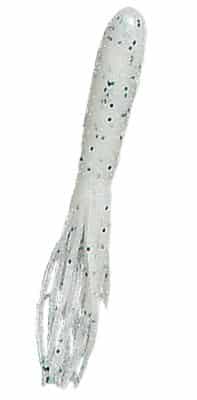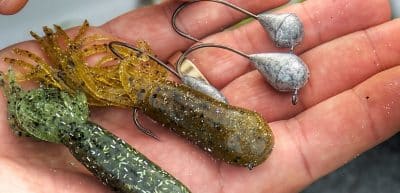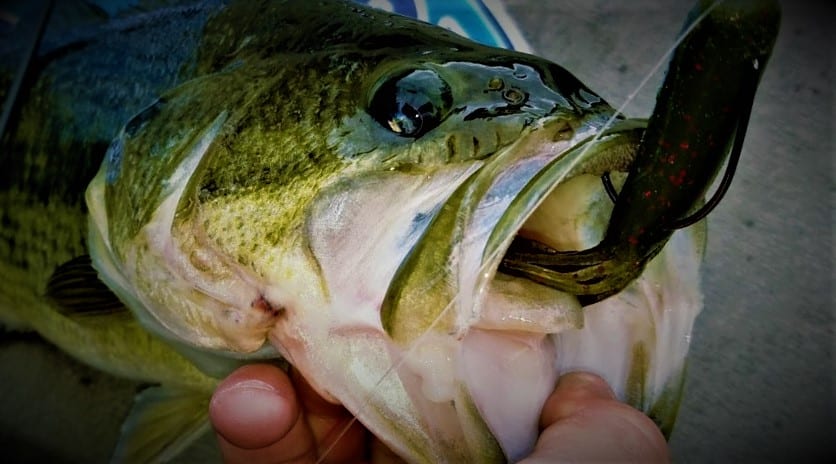Tube Baits have skyrocketed in popularity in recent years. The first tube lure was created in the 70’s catching monster bass in deep clear western reservoirs. Savvy Bass fisherman have long used tubes as a finesse bait, but they’ve recently gone more main stream.
They’re especially popular among fisherman looking for small mouth. Throughout the years they’ve managed to secure a place in my tackle box.
How to Bass Fish With Tube Baits
For some reason fisherman don’t seem to know how to actually fish tube baits. It seems like they research how to use every other lure, but just simply throw their tube out there. So how do you actually fish with a tube bait?
Tube Size Matters
Early tubes maxed out around 3 inches, but sales boomed when manufacturers started offering bigger options. Originally dubbed “supertubes” these oversized tubes quickly became favorites of fishing pros. They offer a deadly alternative to traditional worms and jigs.
Today lure companies are coming out with all sorts of tube baits. You can even choose mutant spinoffs like craw tubes and lizard tubes. Personally I just stick with a basic 3.5-4.5 inch Strike King Tube(Usually in the Crazy Craw Color).
These oversized tubes have been out for years, but anglers still haven’t mastered even the basic tube designs. I’ve talked to a few fishing experts and uncovered a few tips to fishing bass with tube baits.
When Should You Switch to Oversized Tubes?
After years of fishing the same old baits bass learn to reject some of the common options. I’m a huge fan of Zoom Bait Lizards in Murky and brush filled lakes, but they won’t work forever.
Late in the season when bites start to slow down, switch things up and use a tube bait. By the end of the year bass are conditioned to start ignoring lizards, but they’re normally not accustomed to tubes.
Some of my biggest bass have been caught on a 4.5″ Strike King Flip N Tube It’s available in a wide variety of colors, but I prefer lighter colored lures.
It’s surprising just how big the bass are on these little tubes. Even the biggest tubes seem small compared to lizards or worms.
For years I’ve found that tubes catch bigger bass, accounting for most of my yearly records. Other lures tend to catch much smaller fish, but almost all of my tube bass are keepers.
How do Tube Baits Work?
I tend to credit a lot of the tubes success to their erratic action and compact design. It will be sure to entice bass into biting even under adverse conditions.
You’ll even get bites during a cold front when other lures don’t work. Worm or lizard bites usually work best during mild stable weather, but tubes work all year round. There’s just something about the tubes movement that forces bass to strike.
Tube Rigging
There’s a ton of different options for rigging up tube baits. I like to pair my tubes with a 4/0 Gamakatsu Extra Wide Gap Worm Hook.
I’ve been using the same setup for years paired with a basic 3/8 oz slip sinker. It’s a much heavier weight than I like to use with lizards, but it helps stay in contact with the lure. This hook style seems to give me more fish on the boat with less line twist.
Tubes were initially meant as finesse lures, but that doesn’t mean you need to treat them that way. You can fish tubes on serious gear ripping your way through brush. Where lizards, worms and centipedes snag brush a tube will rip through.
The tail and legs of most baits wrap around brush, but a tube will bully its way through. Use your rod tip to gently work over limbs and lower your tip as the bait falls. Try to stay just ahead of the lure so there’s some slack in the line. When the line starts to hop set your hook because it means bass gulped up your tube.
When to Fish for Bass With a Tube Bait
Tubes are an extremely versatile bait that works in loads of scenarios. There are a few places that just scream for the use of a tube.
- Highly Pressured Lakes: Most weekend fisherman aren’t going to be using tubes. They’re going to be chunking worms and lizards hoping for bites. In highly fished areas bass learn to avoid biting on more conventional lures. Switching things up with a tube is sure to get more bites in heavily fished lakes.
- Clear Water: In clear water you’re going to want to use natural looking lures. Tubes give off a natural look mimicking either a bait fish or live crawfish. Switch up your colors and presentation to make it even more natural looking.
- Bedding Bass: You’ll be able to catch a lot of fish by sight fishing bass with tubes. Unlike most other lures tube baits can be fished for a long time in confined areas. Sight fishing is all about learning the attitudes of individual fish. You’ll want to try and physically bump them to provoke a strike.
- Grass: Tubes are easily the best soft plastic bait in submerged vegetation. It will slide right through almost every type of vegetation.
Choose The Right Tube Sinker
Choosing the right sinker is the key to successfully fishing tubes. Tubes require a much heavier sinker than similarly sized lures.
You should go anywhere between 3/8 to 5/16 ounces even in shallow water. The heavier weight will give the lure a popping motion. It will quickly shoot up when you pop the rod tip. When it hits the bottom it will make a little mud cloud like natural prey.
Try pitching a tube into dense cover to catch bass. As the lure drops leave a little bow in the line so the tube will spiral down. Then hop it up with short quick jumps with the rod. Fast action should help catch more bass. Most strikes occur when the lure shoots quickly off the bottom.
How to Fish a Tube Near Brush For Bass
When casting the tube to brush you’re going to want to cast a little past your target. Bring the tube up to cover and then let it fall on a slack line. Try and leave enough slack in your line so that the lure won’t spin away from the brush.
You want the tube to spiral straight down into the middle of coverage. To successfully fish a tube you’re going to need to watch your line. Most bites will be just a little bit of pressure and a slight line twitch.
More Tubing Tips
- Tubes are much smaller than traditional bass lures, but that doesn’t mean they won’t catch big fish. When water isn’t as clear use a heavy line and thick hooks. In clear water you’ll have to size back to lighter line and smaller hooks.
- Most of the time failing to hook bass is caused by improper rigging. Skin-Hooking(sticking the point through the side of the tube) will normally result in more hook-ups. The only downside is your line will be more likely to twist.
- There’s a lot of rigs you can try, but tubes seem to work best in a Caroline Rig. For suspended bass try to insert a piece of plastic foam into the lures head. Use a long leader and light hook.
- Most bass will take a tube deeper than with a worm or lizard. Tubes rarely last more than one good strike. Make sure you bring a large quantity of tubes in a variety of colors.
- Most of the time tubes work best when they’re allowed to spiral down. With a tight line the tube will fall in a curved pendulum fashion. For a straight drop lower the reel as your tube sinks to the bottom. Lowering your rod creates a bow in the line resulting in the perfect action.

